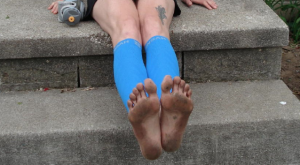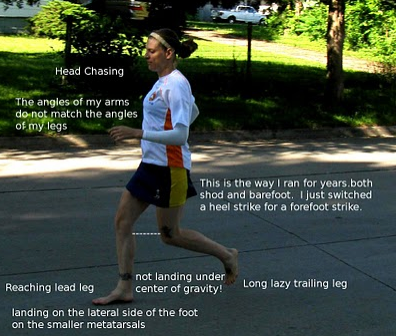 by Angie Hotz aka Barefoot Angie Bee. When I walked into the VIVOBAREFOOT Training Clinic I thought I would “wow” Lee Saxby. I had been successful so far having ran a barefoot marathon and not in “barefoot shoes” but actually naked foot. All of my previous shod race times were bested barefoot. I had been running for two years barefoot and a couple of thousand injury free miles. So when the first thing we did in class was to capture video of ourselves running I thought I was golden.
by Angie Hotz aka Barefoot Angie Bee. When I walked into the VIVOBAREFOOT Training Clinic I thought I would “wow” Lee Saxby. I had been successful so far having ran a barefoot marathon and not in “barefoot shoes” but actually naked foot. All of my previous shod race times were bested barefoot. I had been running for two years barefoot and a couple of thousand injury free miles. So when the first thing we did in class was to capture video of ourselves running I thought I was golden.
What did I humbly discover?
I did not look the way i thought I looked in my mind’s eye!
Not even close even though it “felt” right. Lee said this was the case with everyone. I realized that I had gotten away with running such distances by being light both in my weight and steps and also a fair amount of luck. I was not running efficiently and tempting the fates with a stress fracture and definitely had some nerve issues popping up from the way I was landing. All under the pretense that I knew what my body was doing from the inside out.
I saw that I needed to work on all of the things that are touted as barefoot common knowledge. Posture, cadence, and relaxation. This stuff is said over and over and over in the barefoot community and I totally thought I had it down. I discovered that it is still the foundation but not always built level. You need the right tools to build a level foundation.
How is it that I can think I am doing something and then see that in fact I am no where close. I went barefoot all the time. I listened to my feet. I focused and changed yet there was a habit that needed to be broken and my mind was playing tricks on me that I did not realize until I saw myself running on video.
I had switched heel striking for forefoot striking but I was still reaching and over-striding and leading with my head instead of my chest. I had a very long lazy trailing leg of which threw all semblance of segmentally aligned posture out the proverbial window.

I was humbled and inspired by seeing myself run. I realized that feeling my way through it was not enough. I needed some perspective. I needed some understanding to enhance and realign my intuitive sense. I needed to be able to look at myself from outside myself and hear the input of someone who has a solid understanding of human biomechanics. This perspective was key for me in “getting” the commonly refereed to barefoot nomenclature* and actually connecting mind and body. I got this much needed perspective when I was open to learning to become a coach and being coached myself by Lee Saxby.
When one does something the same way for years and years it is difficult to change those habits. Its entirely possible to change but its not always straightforward nor easy. You can learn how to run barefoot after years and years of running in padded cushioned shoes. You can learn how to run well in shoes with barefoot form but it has to start with taking off your shoes but its also more than just that. The key is to blend understanding with intuition.
Our minds are complex and different parts of our minds work in different ways. We have our movement mind that rules our movements through subconscious thought and then we have our conscious mind.
When we focus consciously on our running form it subconsciously creates stress. You know what I mean. You try something really hard like landing on your forefoot, relaxing those knees, and keeping good posture and your fists ball up, your tongue sticks out, and your neck tenses up. You may have no idea that you are even doing this because you are so focused on your running form.
Now after learning to be a coach I have a place to start. I have a plan to follow. I have something solid to offer and I have tested it on myself and been coached by the best. The coaching I offer is the same thing as I was coached. I video tape you running however you run on a regular basis. So if you wear shoes or not and the average pace that you normally run at is what I want to see. Each person I have coached has responded with a resounding and curious “no” when I ask if they look the way they thought the looked when running!!
The next step is to look at your video frame by frame and assess three things. Posture, rhythm, and relaxation. Next I go through the ideas behind barefoot running of which are based on the different gaits of locomotion we have as humans and how as well as why having good posture, a 180 cadence, and relaxation is key to running.
Next we go through the drills to subconsciously change running form without the stress of trying to consciously make your body move in a certain way. As you focus on doing the drills you will see the new movements gracefully transcend into your running form. The more you practice the better you will get! Then we video again and rinse and repeat as necessary.
All of this is done barefoot. One can’t know how to move if one can’t feel what you are doing. To start off, being barefoot as often as possible is ideal. Walk the dog barefoot. Get the mail barefoot. Just be barefoot as much as possible throughout your day. Feel what its like on grass, gravel, sand, roads, sidewalk, brick, cobblestone, dirt trails. Teaching your mind to think of barefoot as enjoyable instead of something that should be avoided and feared is an important first step in your barefoot running journey.
This essay originally appeared on Barefoot Angie Bee’s blog. Go here.

Great post Angie. Just think how much more efficiently you’ll be running soon after you tweak those areas of imbalances.
Thanks for your insight, Angie!
But what do all those observations of your photo mean, e.g. “long lazy trailing leg”?
Thanks!
Jens,
Most often people look at the lead leg and see that it is reaching out in front of the body to take that step. If you were to land directly under the center of your gravity your trailing leg would also come in closer.
So its interesting to look specifically at the trailing leg. What it should look like is that the line I drew between my knees would be non existent and the leg would form a 90 degree angle. It would correlate with the angle of my arms.
A long lazy trailing leg shows that the limbs are spread out away from the center and reaching for balance when the balance should in fact come from the core being straight up and down and the the limbs make smaller circles close to the body. It takes a lot of energy to send the limbs out and pull them back in during a stride. If the limbs are closer it is more efficient.
The smaller metatarsals are not meant to take great strain so landing on the outside of the foot first and then rolling in like I am doing in the photo above is just asking for a stress fracture! What I should be doing is landing on the first metatarsal and big toe and then a split second later the rest of the forefoot lands and then the heel gently kissed the ground while the arch collapses and gets ready to spring back up. Landing on the outside of the foot throws this action off and begs for injury.
I hope that helped Jens! I am working on a post that shows efficient and improved running form in the near future!
Cheers,
Angie
Steve,
After taking the coaching course with Lee my form has transcended into a knew dimension of fun! Changing ones form is hard work but amazing to see improvement in such short time. Although I must say that upping my cadence was a workout for sure.
I still do drills and practice but my form is much much better than the photo above!
interesting. didn’t leiberman find that barefoot runners naturally land on the outer edge of the foot?
i thought i’ve heard from many top biomechanics folks that normal gait involves landing on the outside of the foot and then pronating inward. i thought most stress fractures of the foot involve the 2nd or 3rd mets or the navicular, not the 5th…
i’m not “saying”, i’m “asking” so i can learn more. can cucuzzella or someone chime in?
thanks!
I was under the impression that what Eric says is also correct – I’m sure I’ve read that from many of the so called biomechanics and running “experts”. I’m sure that with my ankles/lower legs relaxed as they should be, i touch ground first with the lateral edge of the foot (around the ball area although slight differences depending on speed) and gently roll inwards towards the first metatarsal head, before the loading spreads rearward along the longitudinal arches (especially medial) etc etc